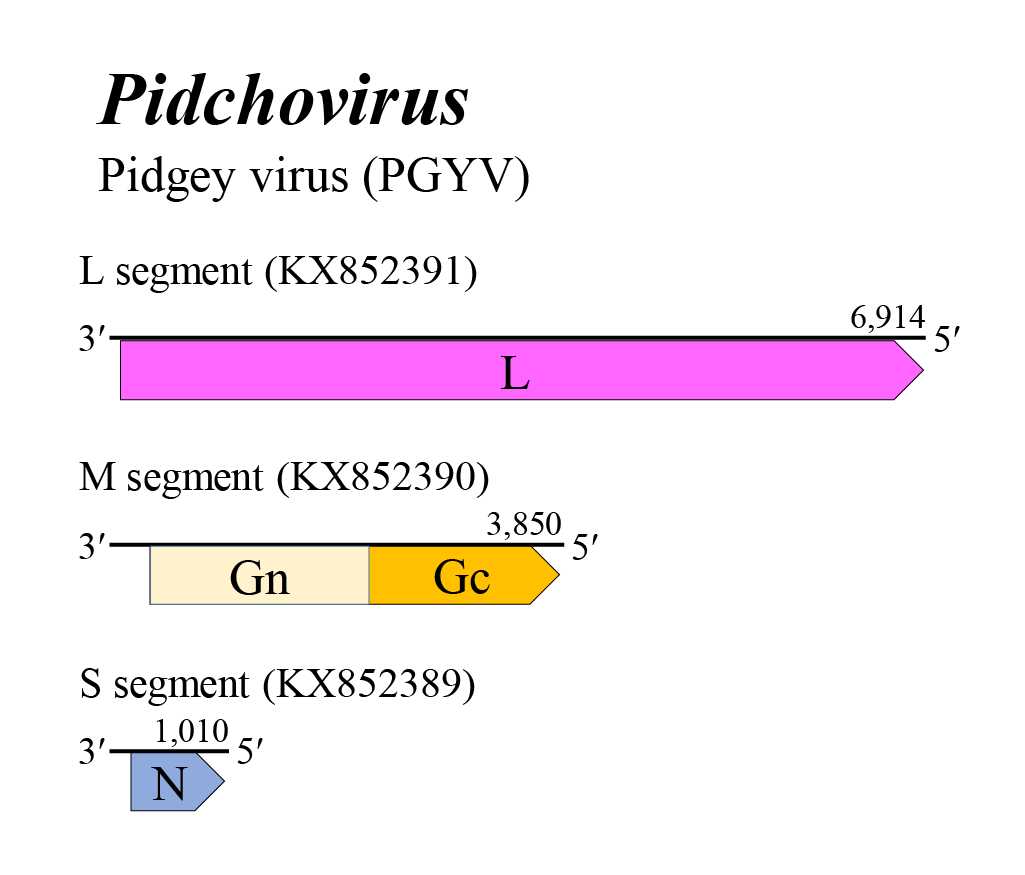Family: Phenuiviridae
Genus: Pidchovirus
Distinguishing features
Two viruses, coleopteran phenui-related virus 308 (CoPrV308) and Pidgey virus (PGYV) are assigned to the genus Pidchovirus. Pidchovirus RNA has been found in RNA from a beetle and a moth. The pidchovirus genome has three genes, encoding a large protein (L), two external glycoproteins (Gn and Gc) and a nucleocapsid protein (N). Based on well-supported Maximum Likelihood or Maximum Clade Credibility trees inferred from complete L protein sequences, viruses classified in the genus Pidchovirus form a monophyletic cluster clearly distinguished from other phenuivirids (Makhsous et al., 2017, Käfer et al., 2019).
Virion
Morphology
Virion morphology is unknown. Based on the putative proteins encoded by the virus genome, the virion is probably a filamentous virion without an envelope.
Nucleic acid and Protein
The pidchovirus genome encompasses three segments of negative-sense RNA. Analysis of the terminal sequences has yet to be completed. All three genomic RNAs contain untranslated regions flanking a single ORF which, based on comparisons with other negative-sense RNA viruses, is predicted to be contained in the virus complementary strand. The L segment (6.9–7.0 kb) encodes a protein with a predicted molecular mass of 263–267 kDa that is homologous with the bunyaviral RNA-directed RNA polymerase (RdRP) domain. The M segment (3.9 kb) encodes a protein of 129–131 kDa that is homologous with phlebovirus glycoprotein G1 and G2 sequences, and with the phlebovirus glycoprotein C-terminal Ig-like domain. The S segment (1.0–1.1 kb) encodes a protein of 30 kDa that is homologous with the tenuivirus/phlebovirus N domain (Table 3 Phenuiviridae) (Makhsous et al., 2017, Käfer et al., 2019).
Genome organization and replication
Pidchovirus genome arrangement is similar to that of beidiviruses, goukoviruses, hudiviruses, hudoviruses, phasiviruses and tanzaviruses (Figure 1 Pidchovirus). The L, M and S segments putatively encode L, a glycoprotein precursor (comprising Gn and Gc) and N, respectively. The Gn and Gc glycoproteins, with predicted molecular masses of 65–73 kDa and 55–56 kDa, were earlier referred to as G1 and G2 based on apparent size following gel electrophoresis. The pidchovirus genome does not encode either of the non-structural proteins, NSm or NSs. Details of virus replication are unknown (Makhsous et al., 2017, Käfer et al., 2019).
 |
| Figure 1 Pidchovirus. Genome organization of a pidchovirus. Coloured boxes depict ORFs that encode N, nucleocapsid protein; Gn and Gc, external glycoproteins; and L, large protein. |
Biology
Pidchovirus RNA has been found by high-throughput sequencing of RNA from spider mite destroyer beetles (Stethorus sp.) and oblique banded leaf roller moths [Choristoneura rosaceana (Harris, 1841)]. The host range of pidchoviruses is likely to be restricted to insects (Makhsous et al., 2017, Käfer et al., 2019).
Species demarcation criteria
The criteria demarcating species in the genus are:
• Less than 95% identity in the amino acid sequence of the RdRP

